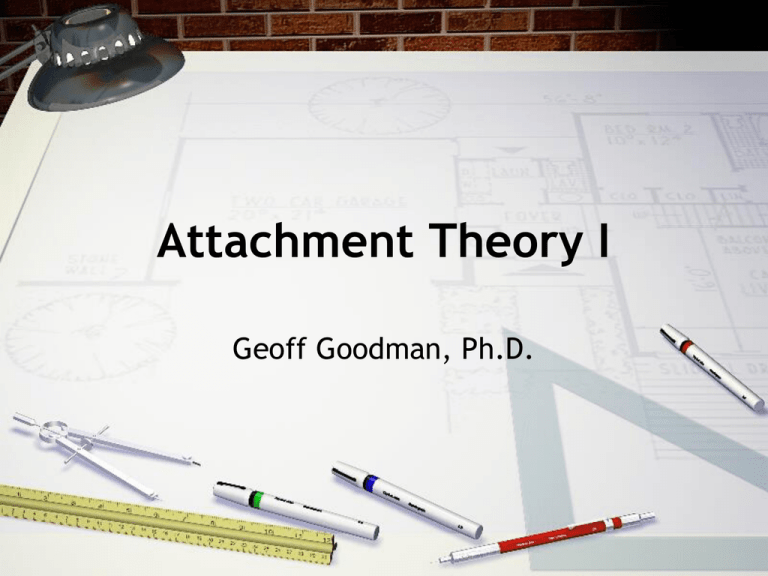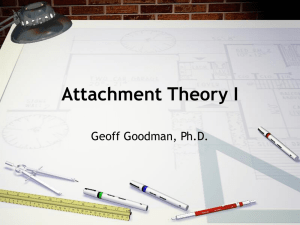Attachment Theory I
advertisement

Attachment Theory I Geoff Goodman, Ph.D. I. Bowlby’s Model of Attachment A. Prolonged separation-- key feature of psychopathology 1. “affectionless” 2. stealing B. Reactions to prolonged separation 1. protest 2. despair 3. detachment Continued… C. Five attachment behaviors to elicit care and protection 1. smiling 2. crying 3. clinging 4. following 5. sucking Continued… D. Difference between object relations and attachment theories 1. object relations: goal= mother 2. attachment: goal= physical proximity to mother 3. later, in attachment theory, goal becomes felt security E. Exploratory behavioral system 1. activated when felt security prevails 2. deactivated when caregiver is absent F. Fear system 1. activates attachment system in response to natural cues of danger a. unfamiliarity b. sudden noise c. isolation 2. deactivated when caregiver becomes available again G. Patterns of affect regulation 1. down-regulate (avoidant) 2. up-regulate (resistant) 3. expectations of interactive attributes of early caregivers influence these patterns H. Additional differences between attachment and psychoanalytic theories 1. use of ethology as a basis for human behavior 2. emphasis on relationships over drives 3. external environment privileged over internal world Continued… 4. emphasis on empirical research over clinical case reports 5. de-emphasis on Oedipus complex 6. de-emphasis on unconscious fantasy 7. de-emphasis on biological vulnerability 8. de-emphasis on bodily pleasures 9. reduction of etiology of trauma to physical separation 10. temperament excluded as influence on development of IWMs II. Theory of Psychopathology A. Developmental pathways model 1. dismissing strategy-- overregulated, dismissing of feelings, especially vulnerable feelings 2. preoccupied strategy-- underregulated, entangled in feelings, especially vulnerable feelings 3. unresolved “strategy”-- absence of strategy or controlling strategy to counteract vulnerable feelings Continued… B. Activation strategy related to dialectic between two different needs 1. sense of relatedness (hyperactivated end of continuum) 2. sense of autonomous identity (deactivated end of continuum) 3. two types of depression a. anaclitic-- need for approval (preoccupied) b.introjective-- perfectionists (dismissing) 4. attachment theory can help refine our predictions about psychopathology by focusing on representational differences C. Disorganized/ unresolved attachment 1. caregiver’s lack of resolution of trauma < age 16 2. frightened or frightening caregiver behavior a. dissociated behavior b. angry, hostile behavior c. mixed messages-- eliciting and rejecting attachment (Lyons-Ruth et al., 1999) D. Continuity of psychopathology 1. quality of care can change, but IWM stays the same (IWMs increasingly resistant to change) 2. representations are derived from expectations developed over time 3. caregiver behavior influences long-term development of infant’s physiological and behavioral regulatory systems that control stress responses (e.g., D infants and cortisol levels) Continued… 4. psychopathology might serve adaptive function to regulate caregiver relationships and maximize felt security 5. lack of mentalization can disrupt relationships and reduce felt security, which further hinders mentalizing capacity III. Advances in Attachment Theory A. Karlen Lyons-Ruth 1. relational diathesis model-- D attachment predisposes individual to further trauma 2. direct and indirect disorganization related to later outcome B. Morris Eagle 1. IWMs reflect fantasy as well as actual interactions a.not temperament affecting actual care b.a temperament (fantasy) can influence perception of that care c.but IWMs can control gene expression 2. Oedipal conflicts are a byproduct of insecure attachment C. Jeremy Holmes 1. three prototypical pathologies of narrative capacity a. clinging to rigid stories (dismissing) b. feeling overwhelmed by un-storied experience (preoccupied) c. inability to find strong narrative to contain traumatic pain (unresolved) 2. treatment recommendations a. story breaking-- rethinking narrative in more coherent fashion b. story making-- elaborating on a healing story to enhance consciousness of one’s own mental life c. dismissing patients-- need to break open self-contained narrative d. preoccupied patients-- capturing confusion and overwhelmed feelings in narrative e. unresolved patients-- finding narrative for traumatic pain D. Arietta Slade 1. dynamics of attachment informs rather than defines intervention strategies 2. listening to linguistic cues and gaps in memories 3. functions of this close linguistic listening a. suggests organizing events in early development b. allows therapist to imagine patient’s earliest experiences and how they impacted patient c. enhances therapist’s empathy by imagining patient’s caregiving experiences concretely Continued… 4. work with children a. both present and past experiences are important b. parents’ IWMs of relationships with own parents and with child modified E. Alicia Lieberman 1. relation of feeling states in current relationships to feeling states with baby 2. internalized early experiences provide structural framework that influences experience of infant care 3. defensive process of infant complement those used by caregiver 4. developmental guidance and supportive treatment implemented with interpretive work IV. Future Directions for Attachment Theory A. Exploration of distortions in child’s perception of external world B. Exploration of developmental variations in IWMs C. Discontinuities in attachment classification related to different developmental periods D. Dimensional nature of attachment categories (both secure and insecure aspects) E. Goal of attachment behavior—not just protection but also containment F. Enrichment of attachment theory’s view of psychopathology with psychoanalytic ideas (e.g., Kernberg)






